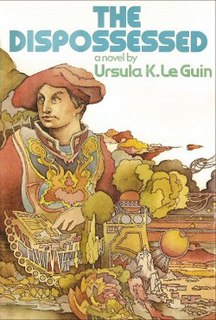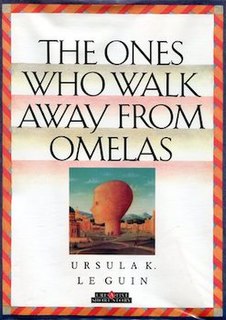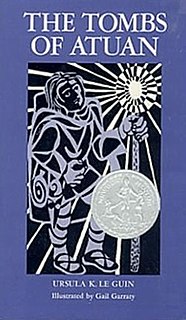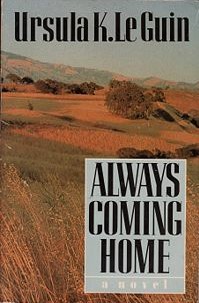An ansible is a category of fictional devices or technology capable of near-instantaneous or faster-than-light communication. It can send and receive messages to and from a corresponding device over any distance or obstacle whatsoever with no delay, even between star systems. As a name for such a device, the word "ansible" first appeared in a 1966 novel by Ursula K. Le Guin. Since that time, the term has been broadly used in the works of numerous science fiction authors, across a variety of settings and continuities.

A Wizard of Earthsea is a fantasy novel written by American author Ursula K. Le Guin and first published by the small press Parnassus in 1968. It is regarded as a classic of children's literature and of fantasy, within which it is widely influential. The story is set in the fictional archipelago of Earthsea and centers on a young mage named Ged, born in a village on the island of Gont. He displays great power while still a boy and joins a school of wizardry, where his prickly nature drives him into conflict with a fellow student. During a magical duel, Ged's spell goes awry and releases a shadow creature that attacks him. The novel follows Ged's journey as he seeks to be free of the creature.
The New Wave was a movement in science fiction produced in the 1960s and 1970s and characterized by a high degree of experimentation in both form and content, a "literary" or artistic sensibility, and a focus on "soft" as opposed to hard science. New Wave writers often saw themselves as part of the modernist tradition in fiction, and the New Wave was conceived as a deliberate break from the traditions of pulp science fiction (SF), which many of the New Wave writers involved considered irrelevant and unambitious. The New Wave science fiction writers of the 1960s thus emphasized stylistic experimentation and literary merit over the scientific accuracy or prediction of hard science fiction writers.

Ursula Kroeber Le Guin was an American author best known for her works of speculative fiction, including science fiction works set in her Hainish universe, and the Earthsea fantasy series. She was first published in 1959, and her literary career spanned nearly sixty years, producing more than twenty novels and over a hundred short stories, in addition to poetry, literary criticism, translations, and children's books. Frequently described as an author of science fiction, Le Guin has also been called a "major voice in American Letters". Le Guin herself said she would prefer to be known as an "American novelist".

The Dispossessed is a 1974 utopian science fiction novel by American writer Ursula K. Le Guin, set in the fictional universe of the seven novels of the Hainish Cycle. It won the Hugo, Locus and Nebula Awards for Best Novel in 1975. It achieved a degree of literary recognition unusual for science fiction due to its exploration of themes such as anarchism and revolutionary societies, capitalism, and individualism and collectivism.

"The Ones Who Walk Away from Omelas" is a 1973 work of short philosophical fiction by American writer Ursula K. Le Guin. With deliberately both vague and vivid descriptions, the narrator depicts a summer festival in the utopian city of Omelas, whose prosperity depends on the perpetual misery of a single child. "The Ones Who Walk Away from Omelas" was nominated for the Locus Award for Best Short Fiction in 1974 and won the Hugo Award for Best Short Story in 1974.

The Tombs of Atuan is a fantasy novel by the American author Ursula K. Le Guin, first published in the Winter 1970 issue of Worlds of Fantasy, and published as a book by Atheneum Books in 1971. It is the second book in the Earthsea series after A Wizard of Earthsea (1969). The Tombs of Atuan was a Newbery Honor Book in 1972.
The Gandalf Awards, honoring achievement in fantasy literature, were conferred by the World Science Fiction Society annually from 1974 to 1981. They were named for Gandalf the wizard, from the Middle-earth stories by J. R. R. Tolkien. The award was created and sponsored by Lin Carter and the Swordsmen and Sorcerers' Guild of America (SAGA), an association of fantasy writers. Recipients were selected by vote of participants in the World Science Fiction Conventions according to procedures of the older Hugo Awards.

Rocannon's World is a science fiction novel by American writer Ursula K. Le Guin, her literary debut. It was published in 1966 as an Ace Double, along with Avram Davidson's The Kar-Chee Reign, following the tête-bêche format. Though it is one of Le Guin's many works set in the universe of the technological Hainish Cycle, the story itself has many elements of heroic fantasy. The hero Gaveral Rocannon encounters lords who live in castles and wield swords, and other races much like fairies and gnomes, in his travels on a backward planet.

Always Coming Home is a 1985 science fiction novel by American writer Ursula K. Le Guin. It is in parts narrative, pseudo-textbook and pseudo-anthropologist's record. It describes the life and society of the Kesh people, a cultural group who live in the distant future long after modern society has collapsed. It is presented by Pandora, who seems to be an anthropologist or ethnographer from the readers' contemporary culture, or a culture very close to it. Pandora describes the book as a protest against contemporary civilization, which the Kesh call "the Sickness of Man".

Tales from Earthsea is a collection of fantasy stories and essays by American author Ursula K. Le Guin, published by Harcourt in 2001. It accompanies five novels set in the fictional archipelago Earthsea.

Dancing at the Edge of the World is a 1989 nonfiction collection by Ursula K. Le Guin.

Robert Paul Holdstock was an English novelist and author best known for his works of Celtic, Nordic, Gothic and Pictish fantasy literature, predominantly in the fantasy subgenre of mythic fiction.

Steering the Craft: Exercises and Discussions on Story Writing for the Lone Mariner and the Mutinous Crew is a 1998 nonfiction book by Ursula K. Le Guin. Developed from a writers' workshop led by Le Guin, the book contains self-guided exercises and discussions focused on the craft of narrative prose.
Virginia Kidd was an American literary agent, writer and editor, who worked in particular in science fiction and related fields. She represented science fiction American authors such as Ursula K. Le Guin, R.A. Lafferty, Anne McCaffrey, Judith Merril, and Gene Wolfe. Wolfe modeled Ann Schindler, a character in his 1990 novel Castleview, in large part on Kidd.
The Complete Short Stories of J. G. Ballard: Volume 2 is a short story collection by J. G. Ballard, published in 2006.

"The Shobies' Story" is a 1990 science fiction novella by American writer Ursula K. Le Guin, describing the story of the first human crew to participate in a newly invented faster-than-light mode of space travel. It was first published in the anthology Universe 1 and subsequently appeared in A Fisherman of the Inland Sea published by Harper Prism in 1994.

Ursula K. Le Guin (1929–2018) was an American author of speculative fiction, realistic fiction, non-fiction, screenplays, librettos, essays, poetry, speeches, translations, literary critiques, chapbooks, and children's fiction. She was primarily known for her works of speculative fiction. These include works set in the fictional world of Earthsea, stories in the Hainish Cycle, and standalone novels and short stories. Though frequently referred to as an author of science fiction, critics have described her work as being difficult to classify.

Fool's Run is a science fiction novel by Patricia A. McKillip. It was first published in hardcover by Warner Books in April 1987, with a paperback edition issued by Questar/Popular Library in February 1988. The first British edition was published in paperback by Orbit in June 1987, with a hardcover edition following from Macdonald in August of the same year. The novel has also been translated into Italian.













